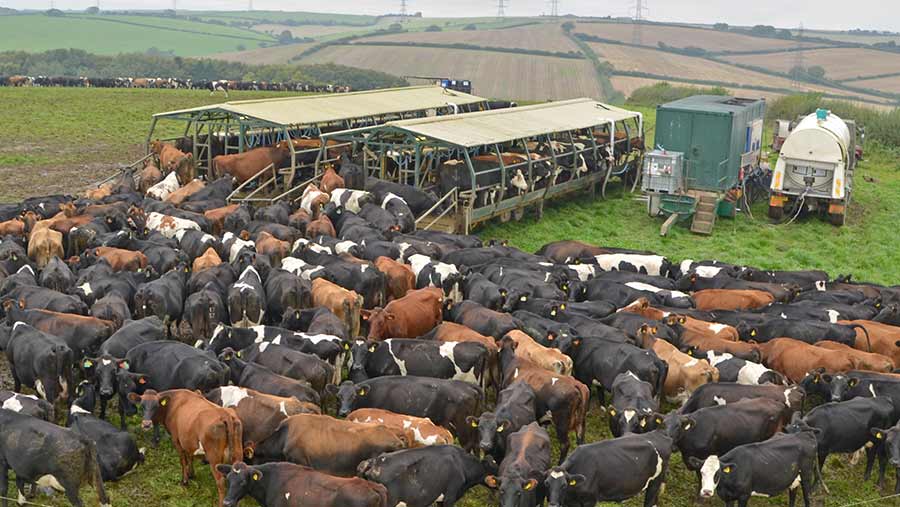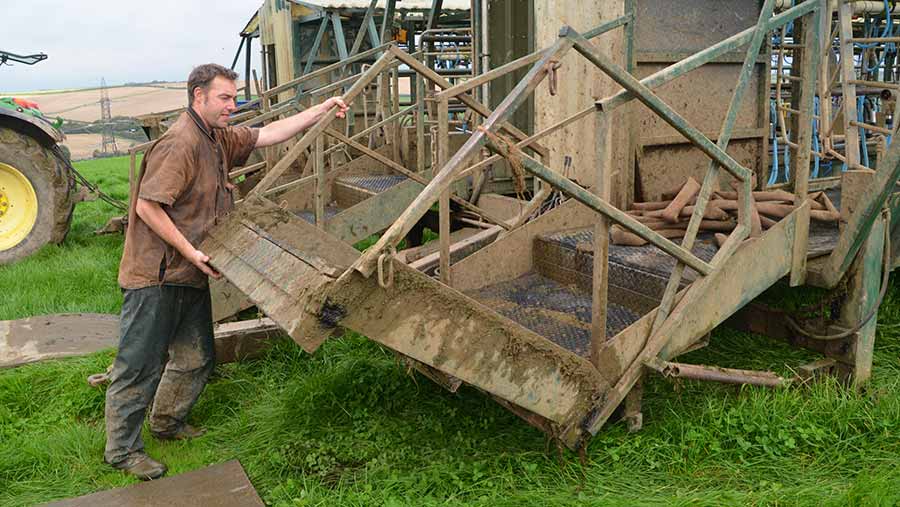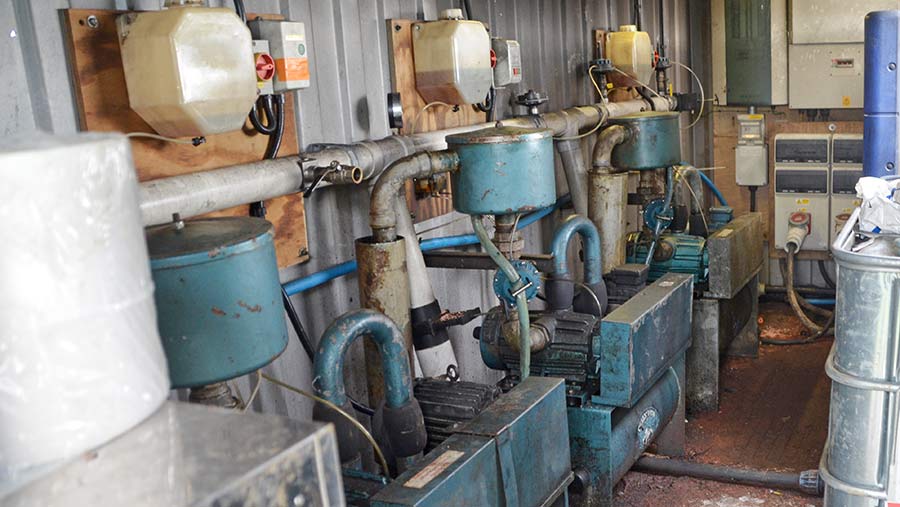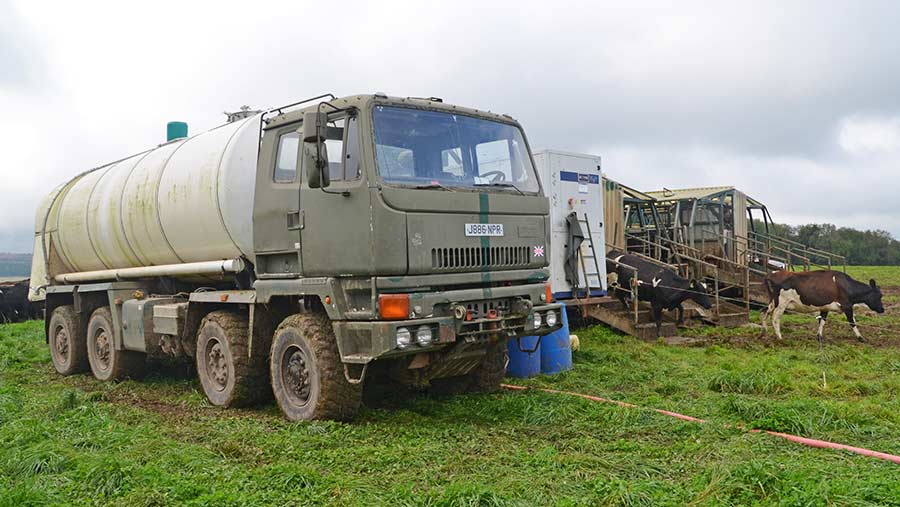Dorset dairy farmers build bespoke outdoor parlour
Four years ago we profiled a dairy herd with a difference – Prospect Farming in Dorset, where the cows not only run outside all year round but are also milked outside through mobile parlours.
Since then quite a bit has changed, with partners Tom Foot and Neil Grigg increasing throughput by moving from hired-in 8-16 milking bails to a pair of their own home-built 20-a-side portable parlours.
“We were fortunate to be offered the tenancy of Longlands Farm in 2011. The land was predominately arable with a modest set of livestock buildings that weren’t really suitable for milking,” says Mr Grigg.
“Our tenancy initially didn’t allow for improvements, so we were reluctant to invest substantially in buildings. We considered a number of options but decided that we could get started by hiring in some temporary milking bails.
“Although they were far from ideal — being time-consuming to move and manual to operate – they proved the concept would work in our situation,” says Mr Foot.
See also: Tips and advice for planning and building a new silage clamp
As cow numbers grew from 460 in that first season to 750 three years later, it became clear that there was a desperate need for extra parlour capacity.
The options were limited for mobile parlours that would have the output potential to deal with serious numbers of cows. With Mr Foot’s self-taught engineering skills, the partners decided that the simplest solution would be to design and build their own tractor-towable rigs.
“Obviously the main criteria was that we could milk a large number of cows quickly and efficiently through any new milking set-up. The difference was that it had to be easy to move,” says Mr Grigg.
“We couldn’t afford to spend a day taking down and then setting up a parlour – it had to take less than an hour to shift from field to field.
“We wanted to keep it simple with milking equipment that you would find in any conventional static parlour. For that reason alone, we knew we wanted to remain with the same layout you would find on any dairy farm.”
Sizing it up
After measuring a friend’s 20-40 herringbone, and with the help of local engineering firm MJ Fry, the pair compiled a set of drawings.
The construction process wasn’t straightforward and by the nature of the job it happened on a fairly ad hoc basis, with a meeting every morning at the workshop to decide how things were going to take shape.
It started out with a pair of chassis rails that would be the backbone of the whole rig, forming the support for the cow stands and the sides of the pit.
Two eight-stud axles were cut in half and modified so that they could be coupled back together using top-link style turnbuckles for transport.
With the parlour in its working position, these are removed to make for free access up and down the pit. (Cranked axles would have ground out too easily.)

Cows queue up to go through the mobile rigs – knowing there’s fresh grass at the other side © Nick Fone
The checker-plate steel platforms down each side are supported by box-section cross-members, which also carry the framework for the breast-bars and roof.
There are a total of 12 hydraulic jack legs along the length of the rig that stabilise the platforms and level the parlour on uneven ground.
Each operated by individual spool-valves, they all run off a single ring-main circuit with oil provided by a flow-and-return service from the tractor that is used to move the parlours.
At the back is a full-width set of shallow steps that the cows climb to enter the parlour. Running on skids, they skim along the surface for field moves.
Up front a pair of folding steps flank the drawbar to provide the exit route for the cows and hinge upwards with the aid of assister springs when the rig is on the move.

Exit steps either side of the drawbar bring the cows back down to earth © Nick Fone
Making it mobile
Each parlour is 4.3m (14ft) wide, so gateways on the main ring-fenced grazing block have all been widened to accommodate the oversize rigs.
It’s a bit of a faff but it is possible for the corrugated plastic roof panels to be removed and the cow platforms split in half to narrow the parlour down to a 10ft transport width, should it ever need to go on the road.
“The basic structure of the system is very straightforward – it just took reels and reels of MIG wire and bucketfuls of Tek screws to get it right,” says Mr Foot.
“The technical challenge was getting all the parlour kit installed. We sourced second-hand clusters, cups and drop-down washers but decided to purchase new Fullwood pulsators and pulsation boxes.”
Three 30-year-old Fullwood vacuum pumps were obtained pretty cheaply and are housed in a plant trailer that is parked alongside the parlours in the field.

Three 30-year-old Fullwood vacuum pumps run the two 20-a-side parlours. They are housed in the main plant trailer © Nick Fone
The trailer is an old twist-lock HGV drag converted by Northamptonshire trailer specialist Merrick Loggin and accommodates a 125kVA generator, milk pumps, compressors, and hot water heater.
A shipping container protects most of the equipment from the elements with a gantry at the rear to carry a ICS Cool Energy milk chiller unit.
The milk is piped directly into an 18,000-litre milk tanker body and can, if required, hold cold milk at a steady temperature for 24 hours without further refrigeration.
The tank is mounted on a six-wheel-drive ex-army DAF eight-wheeler. Bought from MOD dispersal specialist Withams, the 350hp truck is registered as an agricultural vehicle and is more than capable of following the parlours around the farm and then bringing back the cooled milked to the yard for collection.

This 6wd ex-MOD DAF carries an insulated 18,000-litre bulk tanker and transports the herd’s daily output © Nick Fone
Results
Capable of handling about 120 cows an hour, the set-up worked well from the start with very few modifications required — and so in 2013 work started on an identical second rig. The two now run alongside each other, comfortably dealing with 860 cows in a four-hour shift twice a day.
“The key to what we are doing is simplicity. There’s nothing special about what we do – it’s just that our parlours have wheels and we move them from field to field each day,” says Mr Foot.
“People come and visit us to see what we’re doing on a regular basis and a number have been inspired to go away and build their own mobile parlour, which we take as a compliment.
“We have also had a number of enquiries to build our parlour rigs and we’re just starting on our first one this autumn.”
Alongside manufacturing, the enterprising pair have also rebranded the business as The Open Air Dairy.
As a result of public interest in the concept of free-range food, they are working hard alongside their milk buyers, Barbers and Ford Farm, to promote the concept with the mainstream media.
Farm facts
The Open Air Dairy, Longlands Farm, near Dorchester
Farmed area: 396ha plus separate 174ha youngstock and beef unit in Devon
Longlands Farm cropping: 274ha grazing platform, 122ha arable cropping and support cutting/grazing
Soils: predominantly chalk downland
Livestock: 860 NZ Friesian crossbreds, 350 New Zealand Friesian crossbreds heifers, 150 Longhorn X and crossbred steers, 60 New Zealand Friesian crossbred and 15 Longhorn bulls plus 50 Red Devon suckler beef cattle.
Machinery: tractors: 2 x JD 6930s, 6430 and 6420; forage wagon: Strautmann Super Vitesse; parlours: 2 x home-built 20-40 swing-over herringbones; milk tanker: 350hp DAF 8×6 ex-MOD hook-loader
Staff: Tom Foot and Neil Grigg plus six other full-timers

